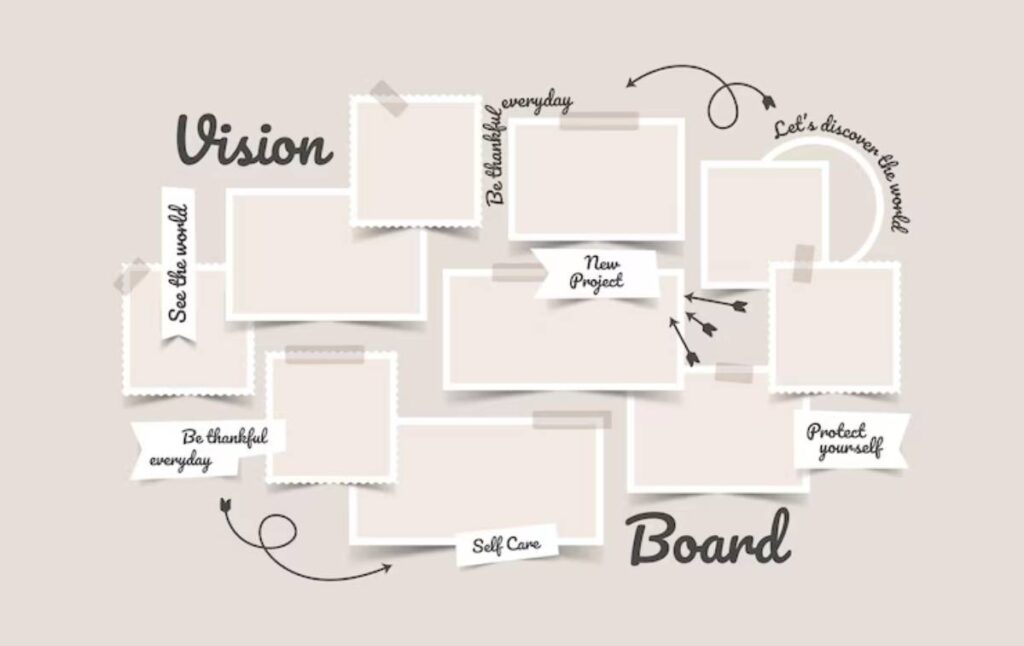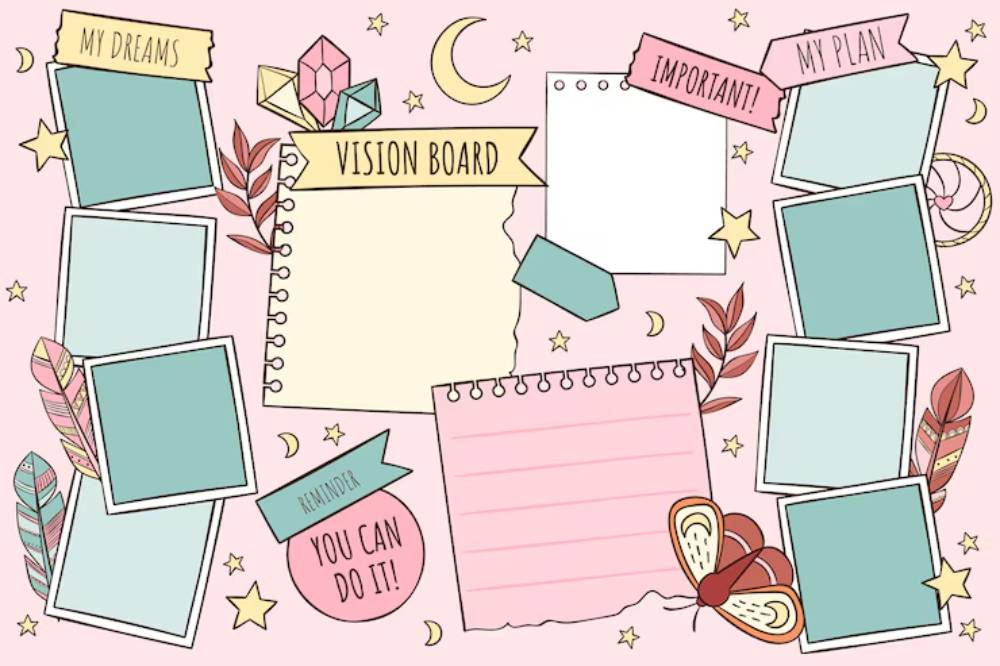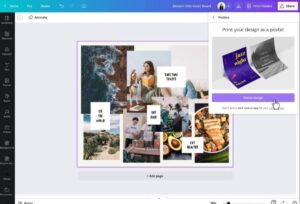The Personal Development Blog

Best Vision Board Layouts for Maximum Clarity
There’s something satisfying about staring at a vision board that just makes sense. You know the kind—everything has its place, your goals are easy to follow, and the board itself feels like a quiet coach gently pointing the way forward.
But here’s the thing: not all vision boards offer that kind of clarity. Some feel more like a chaotic Pinterest mood board—beautiful, yes, but not exactly helpful when you’re trying to stay focused on your biggest goals.
If you’ve ever stared at your board and thought, “I love the vibe, but I don’t know where to start,” this guide is for you.
Let’s explore the best vision board layouts for maximum clarity—the ones that don’t just look good but actually help you live your vision. Along the way, you’ll discover practical vision board ideas, strategic layout for goals, and even a few easy-to-adapt clarity board templates.
Why Vision Board Layout Matters

Before diving into designs, let’s get something straight: layout isn’t just about aesthetics. It’s about function.
A thoughtful layout helps:
- Prioritise your focus
- Categorise your goals
- Visualise progress clearly
- Reduce overwhelm
- Create emotional and visual balance
Think of your board like a map. A good one gets you where you want to go. A messy one? It might look cool, but you’ll probably get lost.
Layout 1: The Life Area Grid (a.k.a. The “Goal Zone”)
Best for: People who want to cover multiple life categories with structure.
How It Works:
Divide your board into 6 to 9 zones, each representing a life area:
- Career
- Health
- Finances
- Relationships
- Travel
- Spirituality
- Personal Growth
- Creativity
- Home
Each zone gets its own mini-collage. You can use labels or colours to keep sections distinct. This format helps balance your vision and prevents one area from dominating.
Why It Brings Clarity:
Each goal has a home. You don’t have to search for your “fitness” dreams—they’re right where they belong.
Layout 2: The “Now, Next, Later” Timeline
Best for: Action-takers who like short-term focus with long-term vision.
How It Works:
Break your board into three clear sections:
- Now: Goals to focus on in the next 1–3 months
- Next: Goals for 3–6 months from now
- Later: Goals that live in the 6-month to 1-year range (or beyond)
Each section includes images, quotes, and mini action steps.
Why It Brings Clarity:
It helps organise priorities. Instead of feeling like everything has to happen at once, you can see which goals need attention now—and which can wait.
Layout 3: The Central Vision (a.k.a. Bullseye Board)
Best for: Big-picture thinkers who want to anchor around one core goal.
How It Works:
Put your biggest goal in the center of the board—an image, word, or quote that captures your main focus.
Surround it with supporting goals that feed into or align with that core.
For example:
- Centre: Start your own business
- Around it: Design your logo, learn basic accounting, quit your day job, set up a home office
Why It Brings Clarity:
Everything flows toward one outcome. There’s less distraction. Less noise. Just steady movement toward a single, bold direction.
This format pairs beautifully with Creating a Centrepiece Image for Your Vision Board to make your core goal stand out.
Layout 4: The Pathway Design (The Visual Journey)
Best for: Creatives and visual learners who love metaphor and flow.
How It Works:
Imagine your board as a path—left to right, bottom to top, or even a winding road. Each step on the path represents a phase or goal milestone. You can place footprints, arrows, or even literal road imagery to show movement.
Why It Brings Clarity:
It tells a story. Instead of static images, you see motion—like your life unfolding with intention.
Layout 5: Minimalist Style (a.k.a. White Space Wins)
Best for: Visual declutterers who get overwhelmed easily.
How It Works:
Choose no more than 3–5 major goals.
Each one gets a clean, open space with:
- One powerful image
- One short phrase or affirmation
- One action cue (a sticky note or icon)
Everything else? Blank space. Let it breathe.
Why It Brings Clarity:
Less truly is more. A minimalist layout forces focus and emotional connection. You’re not pulled in 20 directions—you’re anchored in 3.
Layout 6: The Digital Dashboard
Best for: Tech-savvy planners who want multi-board versatility.
How It Works:
Use digital platforms to create separate slides or boards for each goal area. Think of it like tabs on a website.
Your “dashboard” can live in a folder, app, or even an interactive Trello or Notion board.
Each slide holds:
- The vision
- Key actions
- Visual cues
- Motivation anchors
Why It Brings Clarity:
You can dive deep into one area at a time, without physical clutter. Great for long-term planning and goal tracking.
Layout 7: The Intuitive Freestyle
Best for: Emotional processors and artistic personalities.
How It Works:
No rules. Just create. Let your hands and heart guide you. Cut, paste, layer, scribble. Trust that what you need will show up.
Afterward, go back and name the layout. You might find patterns or categories naturally form.
Why It Brings Clarity:
Because clarity doesn’t always come from structure. Sometimes it comes from flow—and meaning you find later.
How to Choose the Right Layout for You

Still unsure which layout fits?
Try asking:
- Do I want structure or freedom?
- Am I focused on one big goal or many?
- Do I like seeing everything at once, or breaking it into parts?
- Am I more drawn to visuals or categories?
- What helps me feel organised but inspired?
Your answers will guide you. And remember—you can combine layouts too. Use a central vision with a timeline around it. Or a path design with minimal zones. Make it yours.
Bonus Tip: Use a Colour Strategy
Colour can be your secret layout weapon. Assign each life area or goal a colour. Then, group visuals accordingly.
Examples:
- Green: health
- Blue: peace or relationships
- Red: passion or creativity
- Yellow: career and learning
It creates visual coding your brain starts to recognise—and that’s powerful.
It’s Not Just Pretty. It’s Purposeful.
At the end of the day, the best layout for goals isn’t the one that looks the most Instagram-worthy. It’s the one that speaks to you—quietly, consistently, and with clarity.
A well-designed board becomes more than a collage. It becomes a compass. A motivator. A space where your future self lives a little more vividly.
So don’t just collect images. Organise them. Arrange them. Let them reflect the way your mind works and the path your heart wants to follow.
Learn how this compares to more dynamic layouts in Minimalist vs Collage Style Boards: Which Is Better?.









